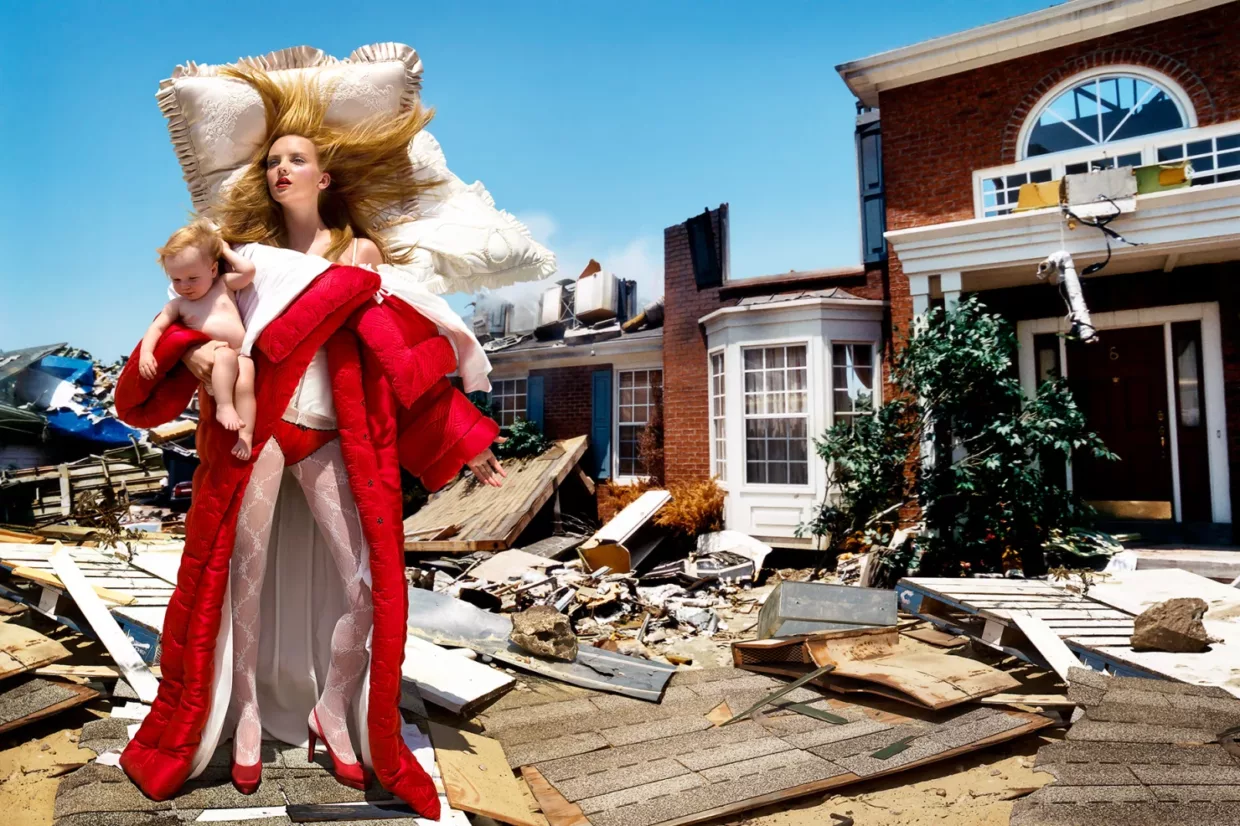David LaChapelle’s controversial high fashion hurricane, two decades on
Feb. 8, 2024
Two decades ago, the photographer David LaChapelle staged apocalyptic scenes for the pages of “Vogue Italia” — images that proved so controversial that they nearly became his final editorial shoot.
In one portrait, which has become the most famous of the series, a blonde woman (Canadian model Heather Marks) poses with a baby in fashionable distress, an expensive suburban home crumbling behind them. Her hair is windswept against a pillow seemingly suspended in the air, as if she’s moved from bed to bedlam; in reality, the ensemble was a surrealist Viktor & Rolf duvet gown fresh off the runway from the label’s Fall-Winter 2005 ready-to-wear collection.
Titled “The House at the End of the World,” the photograph (and the wider series, bearing the same name) was inspired by an inauspicious start to the 2005 hurricane season, LaChapelle explained to CNN. Just before the assignment, which he shot in July, the photographer — known for his vividly saturated, theatrical celebrity portraits and religious-coded fine-art tableaus — was helping his mother protect her windows in Florida ahead of the summer storm season, and thinking about the futility of materiality in the face of disaster. By the time the shoot took place, three hurricanes had already torn across the Gulf of Mexico, with two reaching Florida’s coast. He took this inspiration to high fashion heights, photographing the series at a Universal Studios movie set — which featured memorably in a scene from the 2005 movie “War of the Worlds” — offering a realistic backdrop of destruction.
But in late August, just over a month later, the category 3 storm Hurricane Katrina made landfall in Louisiana, leaving a path of ruination in the Gulf Coast that made it one of the deadliest and most expensive hurricanes in modern history.
“We’re seeing all of these things come to pass now, but even at that time, when I did this photograph, my mind was very much on the climate,” LaChapelle said.
“Climate change is real. These hurricanes are happening. They’re getting fiercer and stronger. And multiplying, and we’re shopping,” he added, noting that it felt like a “paradoxical” period as he brought these themes to the pages of glossy fashion magazines.
The Vogue Italia issue in which his photographs were eventually printed was poorly timed, coming out just weeks after the chaos of Katrina.
“Some people thought that they (the photographs) were exploitive of Katrina,” LaChapelle said; among the glamorized ruins and designer shoes showcased, one image in particular featured models handing off sandbags. “People didn’t understand… how long it takes magazines to reach publication.”
A 2003 series LaChapelle had shot for ID magazine, “Jesus is my Homeboy,” had also caused controversy for showing a Christ-like figure in familiar biblical scenes restaged in contemporary life. Feeling as if his career in fashion was “done,” LaChapelle said, he retreated to a quieter life in Maui and started a new chapter of fine-art photography and gallery shows. (In recent years, however, he’s returned to commercial work, too, taking photographs of Doja Cat and Travis Scott.)
Now, though, “The House at the End of the World,” has become an important touchstone in LaChapelle’s portfolio. It appeared in his first museum retrospective at Fotografiska in New York in 2022, and is now on view at Miami’s VISU contemporary gallery, in the show “Happy Together,” which features a collection of his photographs from the mid-1980s to today.
The series — a provocative, maximalist take on a fashion editorial — was representative of images that LaChapelle was making at that time, but it also heralded what was to come. The following year, LaChapelle began a new series, “After the Deluge,” that pushed him into a painterly, fantastical realm, using extreme natural disasters and acts of God as allegory. (LaChapelle, who is religious, has often returned to biblical themes in his work.) He continued to explore excess and overconsumption, with worldly riches underwater and art museums flooded, pointing to a shift in the art world as auction prices have soared and art fairs have become the playgrounds of the ultrawealthy.
“It’s become so much about money,” he said. “And I was like, ‘Well, is that priceless painting or sculpture going to save you? Can you use that as a raft… at the end of your life?”
Lately, LaChapelle’s visions of environmental disasters have felt more prescient as extreme flooding has increased in severity around the world, as have wildfires due to drought — including on the island that that LaChapelle calls home. The end of the world will not be glamorous, but the urgency of his work has come to pass.
Source: CNN

